WARSAW UPRISING: BID TO EXPEL NAZI ENEMY
Warsaw, Occupied Poland · July 29, 1944
By July 1944 Poland had been occupied by the forces of Nazi Germany for close to five years and by those of the Soviet Union for considerably less. The Polish resistance Home Army (Armia Krajowa), which was loyal to the London-based Polish government-in-exile, had long planned some form of insurrection against their German occupiers. The Home Army’s initial plan was to link up with the invading forces of the Western democracies, which excluded the Soviet Union. However, in 1943, with the invasion of Western Europe (it would be in Normandy, France) months away, it appeared that the Red Army would reach the pre-war borders of Poland first. On this date in 1944 in Warsaw’s suburbs, citizens heard the sounds of battle as German forces counterattacked the approaching Soviets. Two days later Soviet forces were on the defensive. Unaware of this, the Home Army launched a revolt against their oppressors. German forces, including SS (Schutzstaffel) units, ruthlessly put down the two-month-long Warsaw Uprising at a cost of 25,000 German casualties. By the time the Home Army capitulated on October 2, upwards of 250,000 Poles had been killed—a quarter of Warsaw’s population at the time—and 15,000 had been captured. The Germans ordered the city’s evacuation, and 350,000–550,000 civilians were passed through a transit camp on their way to death and concentration camps or other locations. The ferocity of the freedom fighters enraged Germany’s leaders. Adolf Hitler declared, “Warsaw has to be pacified, that is, razed to the ground,” and SS chief Heinrich Himmler issued orders to make the city “completely disappear from the surface of the earth.” Warsaw was to be turned into little more than a military transit station. The Germans diverted considerable resources to destroying the city. Demolition squads used flamethrowers and explosives to methodically destroy buildings street by street, paying special attention to historical structures, the Polish national archives, and other places of national interest—this under the supervision of German scholars no less. By January 1945, when Warsaw was liberated at the start of a massive new Soviet offensive, roughly 85 percent of the city lay in ruins. The Soviet offensive would take the Red Army to the former borders of the Reich on January 26, 1945, and to the gates of Berlin on April 16.
[amazon_carousel widget_type=”ASINList” width=”600″ height=”200″ title=”Recommended Reading” market_place=”US” shuffle_products=”False” show_border=”False” asin=”0299207307,1590176650,0674068149,1840183977,0521531195,0781810353,0781813026,1848842813,0143035401,0312263767″ /]
Poland’s Warsaw Uprising, August 1 to October 2, 1944
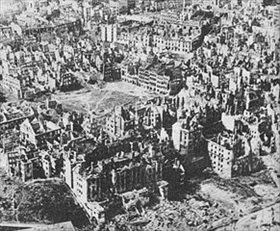 | 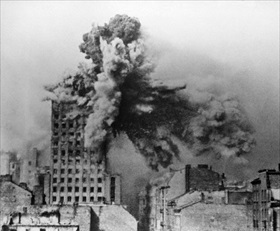 |
Left: An aerial view of Warsaw taken in January 1945. Post-war estimates of material losses were put at 10,455 buildings, 923 historical buildings (94 percent), 25 churches, 14 libraries including the National Library, 81 primary schools, 64 high schools, the University of Warsaw, the Warsaw University of Technology, and most of the city’s historical monuments. Almost a million inhabitants lost all their possessions.
![]()
Right: On August 28, 1944, the Germans used “Mörser Karl,” a self-propelled siege mortar, to fire 2‑ton mortar shells into the Prudential building, Warsaw’s first skyscraper.
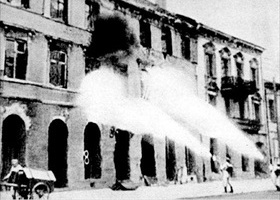 | 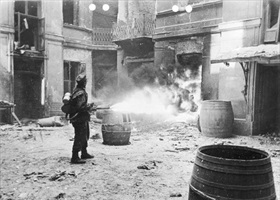 |
Left: During the German invasion of Poland in 1939, much of Warsaw’s Old Town was badly damaged by the Luftwaffe’s campaign of terror bombing. After the Warsaw Uprising (August 1 to October 2, 1944), what had been left standing was systematically blown up or torched by flame-throwing units of German Army, as shown in this photo. The destruction of Warsaw’s Old Town was so thorough that city fathers resorted to 18th‑century oil paintings and pre-war architectural drawings to guide them in reconstructing the historic district. The New Town was only partially restored to its former state.
![]()
Right: A German caption accompanying this photo read: “Each nest of insurgents must be individually smoked out. The flames of this flamethrower crushed every instance of resistance that kept popping up from this hard-to-reach cellar.”
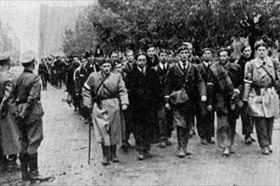 | 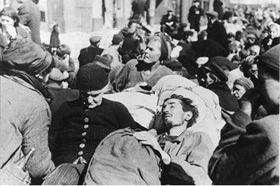 |
Left: Soldiers of the underground Polish Home Army surrender to the German Wehrmacht at a checkpoint in Warsaw, October 5, 1944, two days after their leaders had surrendered to the German Army in a formal signing ceremony. According to the agreement, the Wehrmacht promised to treat Home Army soldiers in accordance with the Geneva Convention, and to treat the civilian population humanely. But within days the entire civilian population of Warsaw was expelled from the city. Out of a half million evacuees, 90,000 were sent to labor camps in the Third Reich and 60,000 were shipped to death and concentration camps.
![]()
Right: Sick and starved people emerge from basements and sewers in Warsaw in October 1944, two months after the start of the Warsaw Uprising. Some people continued hiding in the deserted city and were called “Robinson Crusoes” or “cavemen.” The Germans called them “rats” and killed them when found. Among the best-known “Crusoes” was Władysław Szpilman, whose memoire The Pianist was turned in a film of the same name.
Survivors and Contemporary Footage Recount the Warsaw Uprising, August 1 to October 2, 1944
![]()

 History buffs, there is good news! The Daily Chronicles of World War II is now available as an ebook for $4.99 on Amazon.com. Containing a year’s worth of dated entries from this website, the ebook brings the story of this tumultuous era to life in a compelling, authoritative, and succinct manner. Featuring inventive navigation aids, the ebook enables readers to instantly move forward or backward by month and date to different dated entries. Simple and elegant! Click
History buffs, there is good news! The Daily Chronicles of World War II is now available as an ebook for $4.99 on Amazon.com. Containing a year’s worth of dated entries from this website, the ebook brings the story of this tumultuous era to life in a compelling, authoritative, and succinct manner. Featuring inventive navigation aids, the ebook enables readers to instantly move forward or backward by month and date to different dated entries. Simple and elegant! Click 











